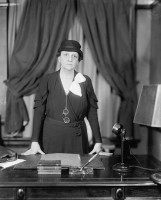Widgetized Section
Go to Admin » Appearance » Widgets » and move Gabfire Widget: Social into that MastheadOverlay zone
Frances Perkins: Shattering the Glass Ceiling
The views expressed are those of the author and do not necessarily reflect the views of ASPA as an organization.
By Terry Newell
February 13, 2015
Americans jealously guard the social safety net—Social Security, unemployment insurance, minimum wage laws and workplace health/safety standards. But few know how these came to be. Frances Perkins, the first female Cabinet member, blazed that trail.
Preparing for a Challenge
 When newly-elected President Franklin Delano Roosevelt (FDR) met with her February 22, 1933, Perkins knew what he would ask. She had known him since 1910. As governor, he picked her to lead the New York State Industrial Commission, where she strengthened worker safety and implemented unemployment insurance, a hotly debated idea. He also admired her command of employment statistics, especially when she disputed President Hoover’s 1930 assertion that the Depression was almost over.
When newly-elected President Franklin Delano Roosevelt (FDR) met with her February 22, 1933, Perkins knew what he would ask. She had known him since 1910. As governor, he picked her to lead the New York State Industrial Commission, where she strengthened worker safety and implemented unemployment insurance, a hotly debated idea. He also admired her command of employment statistics, especially when she disputed President Hoover’s 1930 assertion that the Depression was almost over.
Offered the post of Secretary of Labor, she knew that some agency staff threatened to resign rather than serve under a woman. Even the Baltimore Sun had written that “A woman smarter than a man is something to get on guard about. But a woman smarter than a man and also not afraid of a man, well, good-night.”
Yet she would not turn FDR down. She laid out a plan. After cleaning corruption out of the department, she would put people back to work through public works projects, deal with child labor, ensure a minimum wage, a national system of unemployment insurance and an old-age pension system. “You don’t want me for Secretary of Labor if you don’t want these things done,” she told him. “I’d be an embarrassment to you because when I start a thing, I round up the cohorts. I get out advisory committees who really become supporters of the idea. You get a public demand for it the next thing you know.”
Breaking the Glass Ceiling and Putting a New Floor Under American Workers
Perkins had the political savvy to navigate in a male-dominated world. She moved slowly. At official functions, she asked to be seated with Cabinet members’ wives rather than with the office-holders. In Cabinet meetings, she let the men speak first. Vice president, John Nance Garner recalled, “She didn’t interrupt. She didn’t butt in . . . She kept still until the president asked her what she had to say.”
The first year of Roosevelt’s presidency focused on getting people back to work, through such programs as the Civilian Conservation Corps, in which Perkins played a major role. She built a reputation for resolving labor-management disputes and nurtured relationships with FDR’s intimates, including his wife Eleanor.
She then pressed forward. “I took it upon myself to mention unemployment insurance at least every second meeting of the Cabinet – just to mention it so that it wouldn’t . . . get out of people’s minds.” The depression provided an opportunity she was determined to seize. “It is probably our only chance in 25 years” to get a bill through Congress dealing with both [unemployment insurance and old-age pensions],” she told FDR.
Roosevelt backed unemployment compensation but, facing business opposition, publicly wavered. A furious Perkins marched to the White House. The next day he backed off and even encouraged a more comprehensive approach.
In June 1934, she suggested that a high-level group prepare a bill. She liked committees as a tool to gain support and get programs right. “It is our American habit to arrive at what we think by talking things out together. These discussion centers are the actual birth places of public opinion.”
She confronted a constitutional question: would the Supreme Court uphold social insurance mandated by the federal government? She identified the “swing” justices and approached them. At a party, she confided to Justice Harlan Stone her worries that unemployment and old-age insurance might not pass constitutional muster. He could not officially comment yet gave her crucial advice, ‘The taxing power, my dear, the taxing power.” So, rather than the “dole,” which FDR hated, people and businesses would be taxed, with the money set aside for unemployment insurance and Social Security.
Near the end of December, with the committee locked in disagreement and its deadline looming, she locked the members in her home, put a bottle of Scotch on the table and kept them at it until 2 a.m. They produced a unanimous report.
As the bill went through Congress, she accepted amendments. Getting a law passed which could be modified was better than no law at all. When it became clear that old-age insurance was popular but unemployment insurance was controversial, she flipped their positions in the bill to put the more acceptable measure first.
On Aug. 9, 1935, the bill passed the House 371-33 and the Senate 77-6. FDR signed it five days later. “I don’t think that President Roosevelt had the remotest interest in a Social Security bill or program,” Maurine Mulliner, an incoming member of the Social Security Board said. “He was simply pacifying Frances.”
A formidable and dedicated public servant, Perkins led the way for many more women to follow.
Author: Terry Newell is president of Leadership for a Responsible Society and former dean of faculty at the Federal Executive Institute. He can be reached at: [email protected].


Follow Us!